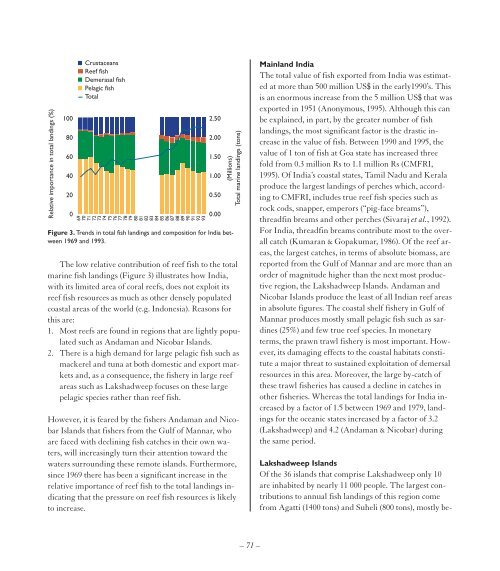Create successful ePaper yourself
Turn your PDF publications into a flip-book with our unique Google optimized e-Paper software.
Relative importance in total landings (%)<br />
100<br />
80<br />
60<br />
40<br />
20<br />
0<br />
Crustaceans<br />
Reef fish<br />
Demerasal fish<br />
Pelagic fish<br />
Total<br />
69<br />
70<br />
71<br />
72<br />
73<br />
74<br />
75<br />
76<br />
77<br />
78<br />
79<br />
80<br />
81<br />
82<br />
83<br />
84<br />
85<br />
86<br />
87<br />
88<br />
89<br />
90<br />
91<br />
92<br />
93<br />
2.50<br />
2.00<br />
1.50<br />
1.00<br />
0.50<br />
0.00<br />
(Millions)<br />
Total marine landings (tons)<br />
Figure 3. Trends in total fish landings and composition for India between<br />
1969 and 1993.<br />
The low relative contribution of reef fish to the total<br />
marine fish landings (Figure 3) illustrates how India,<br />
with its limited area of coral reefs, does not exploit its<br />
reef fish resources as much as other densely populated<br />
coastal areas of the world (e.g. Indonesia). Reasons for<br />
this are:<br />
1. Most reefs are found in regions that are lightly populated<br />
such as Andaman and Nicobar Islands.<br />
2. There is a high demand for large pelagic fish such as<br />
mackerel and tuna at both domestic and export markets<br />
and, as a consequence, the fishery in large reef<br />
areas such as Lakshadweep focuses on these large<br />
pelagic species rather than reef fish.<br />
However, it is feared by the fishers Andaman and Nicobar<br />
Islands that fishers from the Gulf of Mannar, who<br />
are faced with declining fish catches in their own waters,<br />
will increasingly turn their attention toward the<br />
waters surrounding these remote islands. Furthermore,<br />
since 1969 there has been a significant increase in the<br />
relative importance of reef fish to the total landings indicating<br />
that the pressure on reef fish resources is likely<br />
to increase.<br />
Mainland India<br />
The total value of fish exported from India was estimated<br />
at more than 500 million US$ in the early1990’s. This<br />
is an enormous increase from the 5 million US$ that was<br />
exported in 1951 (Anonymous, 1995). Although this can<br />
be explained, in part, by the greater number of fish<br />
landings, the most significant factor is the drastic increase<br />
in the value of fish. Between 1990 and 1995, the<br />
value of 1 ton of fish at Goa state has increased three<br />
fold from 0.3 million Rs to 1.1 million Rs (CMFRI,<br />
1995). Of India’s coastal states, Tamil Nadu and Kerala<br />
produce the largest landings of perches which, according<br />
to CMFRI, includes true reef fish species such as<br />
rock cods, snapper, emperors (“pig-face breams”),<br />
threadfin breams and other perches (Sivaraj et al., 1992).<br />
For India, threadfin breams contribute most to the overall<br />
catch (Kumaran & Gopakumar, 1986). Of the reef areas,<br />
the largest catches, in terms of absolute biomass, are<br />
reported from the Gulf of Mannar and are more than an<br />
order of magnitude higher than the next most productive<br />
region, the Lakshadweep Islands. Andaman and<br />
Nicobar Islands produce the least of all Indian reef areas<br />
in absolute figures. The coastal shelf fishery in Gulf of<br />
Mannar produces mostly small pelagic fish such as sardines<br />
(25%) and few true reef species. In monetary<br />
terms, the prawn trawl fishery is most important. However,<br />
its damaging effects to the coastal habitats constitute<br />
a major threat to sustained exploitation of demersal<br />
resources in this area. Moreover, the large by-catch of<br />
these trawl fisheries has caused a decline in catches in<br />
other fisheries. Whereas the total landings for India increased<br />
by a factor of 1.5 between 1969 and 1979, landings<br />
for the oceanic states increased by a factor of 3.2<br />
(Lakshadweep) and 4.2 (Andaman & Nicobar) during<br />
the same period.<br />
Lakshadweep Islands<br />
Of the 36 islands that comprise Lakshadweep only 10<br />
are inhabited by nearly 11 000 people. The largest contributions<br />
to annual fish landings of this region come<br />
from Agatti (1400 tons) and Suheli (800 tons), mostly be-<br />
– 71 –


















